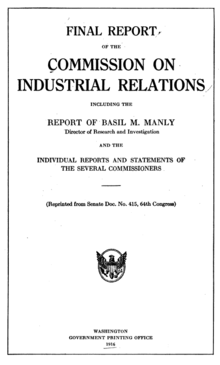
The Commission on Industrial Relations (also known as the Walsh Commission)[1] was a commission created by the U.S. Congress on August 23, 1912, to scrutinize US labor law. The commission studied work conditions throughout the industrial United States between 1913 and 1915. The final report of the Commission, published in eleven volumes in 1916, contain tens of thousands of pages of testimony from a wide range of witnesses, including Clarence Darrow, Louis Brandeis, Mary Harris "Mother" Jones, Theodore Schroeder, William "Big Bill" Haywood, scores of ordinary workers, and the titans of capitalism, including Daniel Guggenheim, George Walbridge Perkins Sr. (of U.S. Steel), Henry Ford, and Andrew Carnegie.[2]
- ^ McCartin, Joseph Anthony (February 1, 1998). Labor's Great War: The Struggle for Industrial Democracy and the Origins of Modern American Labor. UNC Press. ISBN 0-8078-4679-1. p. 12.
- ^ Bobertz, Bradley C. (February 1999). "The Brandeis Gambit: The Making of America's "First Freedom," 1909–1931". William & Mary Law Review. 40. 40 Wm and Mary L. Rev. 557 p. 573